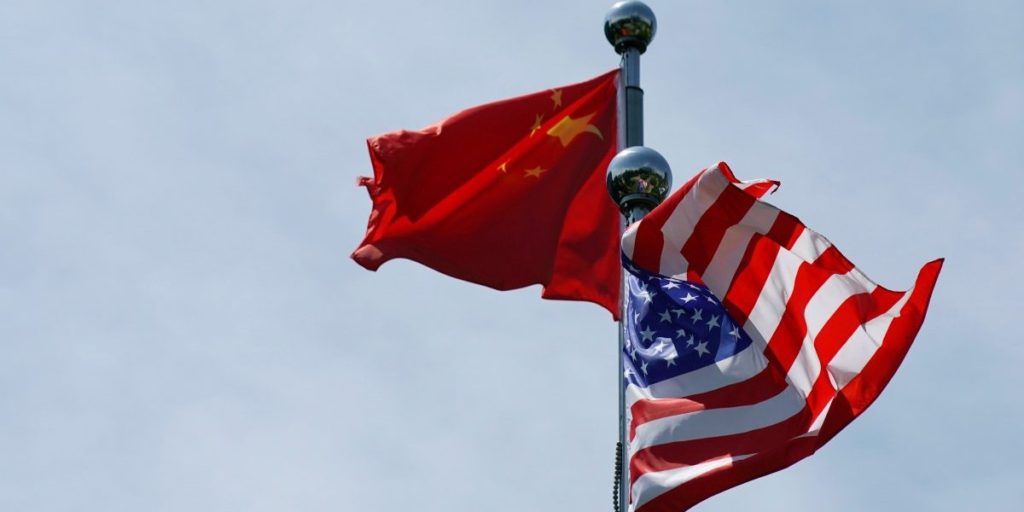Trump, China and Latin America: The US is Losing the Soft Power War

Chinese and US flags flutter near The Bund, Shanghai (Photo: Reuters/Aly Song)
The threat to the US’s positions in Latin America appears to lie in the policies pursued by the Trump administration itself
By Daniel Taylor and Inderjeet Parmar
As we approach the US presidential election in November 2020, amidst a global pandemic that President Donald Trump has seriously mishandled, and angry national and worldwide demonstrations in the wake of the racist police killing of George Floyd, America’s position and prestige has taken a major hit.
If Trump is unpopular at home, how is he faring in what has historically been seen by US elites as ‘Uncle Sam’s backyard’? What effects have Trump’s references to Mexicans as “criminals” and “rapists”, and Latin Americans more generally as vectors of disease, had on the US’s standing in the region? And has the US lost ground in the so-called great geopolitical game that so many have declared is in full swing? Has China really taken over Latin America, made the region “dependent” on its largesse, as US elites, without irony, proclaim?
After all is said and done, the biggest threat to US positions in the Latin American and Caribbean region may be the United States itself, and not any external powers. The golden opportunity for the US to demonstrate global and regional leadership and enhance its soft power – brought about by the COVID-19 pandemic which originated in China – has been squandered.
China has not really won this particular round of the ‘soft power war’, it has been handed the victory largely due to the Trump administration’s botched, divisive and anti-expertise-based approach to combating the coronavirus at home, and its ‘America First’ attitude internationally, including defunding and withdrawing from the World Health Organisation (WHO) in the very middle of the crisis.
Talking up a China threat
According to Professor R. Evan Ellis, a specialist on Latin America at the US Army War College, there is no military threat to US interests in the region. Indeed, the threat has been absent for decades. “Since the end of the Cold War, no US competitor has positioned forces in Latin America or the Caribbean so as to pose a credible threat to the US homeland.”
“Nonetheless,” Ellis continues, “in the event of a global conflict with a rival such as the PRC, the latter could employ its commercial investments in the region, in fields such as shipping, ports, banking, electronics, and manufacturing to project and sustain intelligence agents and other operatives in Latin America” (emphasis added).
Past and present SOUTHCOM commanders are understandably hawkish. Admiral Kurt Tidd, who led SOUTHCOM from 2016 to 2018, reported to the US Senate that “China’s commercial and diplomatic advances move it closer to its larger strategic goal of reshaping global economic and governance architectures.”
SOUTHCOM’s current head, Commander Craig Faller, warns of so-called Chinese ‘dollar diplomacy’, Russia’s military and propaganda footprint, and Russian and Cuban assistance to Venezuela, viewing Cuba as “a gateway for Russia’s access to the Western Hemisphere.”
Yet, there is a strong possibility that a defense department review may yet reduce SOUTHCOM’s $1.2 billion budget. It would appear that even the Trump administration isn’t fully buying the China threat in the region.
US strategic thinkers are protecting their turf, mentally preparing for a possible future war with China, and building up a China-threat narrative to justify their military presence and active interference in the region. And the anti-China narrative is politically functional in an election year.

Trump in the Oval Office at the White House in Washington, May 6, 2020 (Photo: Reuters/Tom Brenner)
Naked self-interest, not hegemony, drives US policy
Despite declarations of defending democracy and human rights in Latin America, US policy under President Trump marches to a different drum: naked self-interest. The Trump administration’s diktat has replaced the idea of leadership, coercion replaced hegemony, bilateralism for multilateralism, and illiberal-authoritarianism stands instead of liberal internationalism. Trump, however, offers a continuation of American strategy and coercive methods, not a radical departure. But he has forcefully backed the most right-wing leaders and regimes. The US has developed and promoted an axis of right-wing authoritarianism throughout the western hemisphere, reflecting the kind of US Trump favours – plutocratic rule underpinned by white supremacy and police power. The racist politics of the “Yellow Peril” – the Chinese ‘threat’ – hover over the US’s regional and international strategies. But, despite remaining the major great power in the region, US legitimacy is being eroded by the very coercive strategies it pursues.
Nevertheless, the US State Department has provided over $112 million in aid to Latin America to fight the coronavirus. Yet, President Trump’s decision to pull funding from the WHO, the Pan-American Health Organisation, (and to leave the Trans-Pacific Partnership that also included Chile, Mexico and Peru), speaks volumes. It demonstrates a commitment to reshaping international and regional relations to maximise US ‘zero-sum’ returns and attempt to maintain a competitive edge over a non-existent threat from China.
But in the process, the US is increasingly alienating international and Latin American public opinion, and unintentionally driving key states into the arms of China and Russia.
Coercive bilateralism – Trump’s new normal
Trump’s illiberal internationalism is partly reflected by US maintenance of bilateral deals such as Free Trade Agreements (FTAs), and multilateral endeavours over groupings of weaker states that strongly favour US firms, such as The Dominican Republic-Central American FTA (CAFTA-DR). Trump has also attempted to secure a fresh trade deal with Brazil, which could seriously undermine the Mercosur market which has acted as an impediment to signing such agreements without permission from other members. The US has taken an especially hard-line approach to its perceived enemies. Mirroring President George W. Bush’s ‘axis of evil’, three regional states have been targeted by the US as a “Troika of Tyranny” – namely Venezuela, Cuba and Nicaragua. Each has relations with other states deemed threats to US national security, including China, Russia, and more spuriously, Iran.
To complicate such matters, Donald Trump has blamed the COVID-19 crisis on China, as the Asian powerhouse woos Latin American statesman through ‘medical diplomacy’. The loss of American soft power in Latin America only fuels fears of China. The recently-resurrected hawkish Committee on the Present Danger: China (CPDC), led by Trump’s 2016 election campaign CEO and erstwhile White House chief of strategy, Stephen Bannon, reflects a growing focus on the Chinese ‘threat’ as a staple of US electoral politics. But there is hardly a mention on the CPDC’s website of any threat from China with regard to Latin America.
Yet, Latin American relations with (the US’s white allies in) the European Union are perceived as less of a threat to the US, despite accounting for 55% of all FDI inflows in the region, compared to the US’s 20%, and China’s paltry 1.1%, according to 2017 UN estimates.
The threat to the US’s positions in Latin America, however, appears to lie in the policies pursued by the Trump administration itself. Trump has barred crucial medical supplies due for Latin America, cut aid to Guatemala, El Salvador and Honduras, over his anti-immigration policies, and is considering a full travel ban on the region due to COVID-19. He is actively weaponising US power. While Congress has managed to act as a check on Trump’s power, such as by increasing aid to the region, the overall thrust of US realpolitik is clear.

A U.S. dollar banknote featuring American founding father Benjamin Franklin and a Chinese yuan banknote featuring late Chinese chairman Mao Zedong are seen among U.S. and Chinese flags (Photo: Reuters/Jason Lee/File Photo)
China’s regional influence is real but…
Although Latin American states only comprised 1.1% of Chinese F.D.I. in 2017, China sees the area as a huge reservoir of natural resources for its 1.4 billion population, investing largely in energy, agriculture, mining and infrastructure projects. To add to this, Chinese investments in the region tally 4th behind the US, the EU, and Canada, it has been Brazil’s largest trading partner since 2008, when it overtook the US, more firmly embedding it in the region.
China’s Belt and Road Initiative has recruited 19 states in Latin America and the Caribbean, ensuring billions of dollars of investment. The region has therefore increased exports to China during the COVID-19 Crisis, especially Brazilian sugar and soy, and Argentine beef. China likewise has helped provide medical equipment, enhancing its soft power. This adds to the soft power of China’s 41 regional Confucius centres.
China’s regional diplomacy has, however, earned it observer status at the Organisation of American States, membership of the Inter-American Development Bank and the Caribbean Development Bank, and an active role in the Asia Pacific Economic Cooperation forum. Recently, China has provided medical assistance to battle COVID-19. China has also joined a regional forum that excludes the US and Canada – the Community of Latin American and Caribbean States (CELAC). The forum states agreed to a five-year cooperation plan involving security, trade, investment, finance, infrastructure, energy, agriculture, science, and people-to-people exchanges. And at least 19 regional states are participating in the Belt and Road Initiative.
Meanwhile, Russia is perceived to undermine US leadership through enhancing energy, trade, arms transfers, and anti-drug arrangements in the region. Russian relationships in Latin America were viewed as early as 2015 as a return to Cold War tactics by John Kelly, the-then head of US SOUTHCOM. Nevertheless, Russian influence remains limited.
On the other hand, US military power in the region is unparalleled – it has 76 military bases in the Latin America and Caribbean region, as well as the 4th US naval fleet. Colombia’s military is increasingly close to NATO, while US SOUTHCOM works in close conjunction with the Brazilian military. Yet, the over 50 port agreements China’s negotiated in the region, and its being the US’s largest and Latin America’s second biggest trading partner, while the reach of its Belt and Road Initiative expands to Argentina, is raising eyebrows in the US. Yet, China has no naval, air or military bases in the region.
Venezuela – maximum pressure campaign intensified
In echoes of President Richard Nixon’s instructions to the CIA regarding Chile in the early 1970s, Trump’s strategy is to make Venezuela’s economy ‘scream’. Trump placed a bounty on President Maduro’s head on narco-terrorism charges and, more recently, backed mercenaries’ failed attempt to overthrow the Venezuelan government. America has imposed sanctions on Venezuela’s imports and exports, has confiscated their foreign currency deposits, assets and gold reserves, and prevented IMF loans in the midst of the COVID-19 crisis. The US also backed a failed military intervention by mercenaries to overthrow the Venezuelan government.
But China has managed to fill some of Venezuela’s funding gaps. 40% of China’s regional loans, often tied in with oil bartering, now head to beleaguered Venezuela. China also supports Venezuela on satellite projects, infrastructure and mining research. The Asian powerhouse has furthermore helped Venezuela gain a seat on the United Nations Human Rights Council. Yet, the dire state of its economy, especially impacted by long-term US sanctions, and the collapse of oil prices, has pushed over 90% of Venezuelans into poverty.

Venezuela’s president, Nicolas Maduro, displays the identity papers of US mercenaries captured in his country (Photo: TeleSur)
The Brazilian dilemma – a Trumpist president, China’s largest trading partner
Brazil’s pro-Trump President Jair Bolsonaro, sometimes referred to as “Trump of the Tropics”, has threatened to leave the WHO, while his son blames China for the COVID-19 crisis. Brazil also voted with the US against a UN General Assembly resolution denouncing the US embargo against Cuba. Brazil recently cancelled a BRICS Plus meeting which had included other regional members who refused recognition of Juan Guaido as president of Venezuela.
But while ideology, politics and diplomacy demand friendship with Trump, pragmatism and Brazilian big business demand a strong economic relationship with China. Brazil’s domestic economy is very much intertwined with China’s and considerable internal pressures remain for Brazil not to break such relations so as not to impact agricultural and mining exports and its ongoing BRICS relationship.
US standing in Brazil, and the rest of Latin America, is at rock bottom. Prior to the pandemic, President Trump had slashed aid to El Salvador, Guatemala, and Honduras by almost 33% of the amount allotted by Obama in 2016. An additional $3 billion decrease in international global health programmes. Of the $73 million in pandemic aid indicated in the US State Department’s recent announcements a large proportion is existing funding redirected from other programmes. Finally, Brazil’s health minister recently accused the US of hijacking shipments of medical equipment and supplies Brazil had purchased from China.
Yet, Brazil is second only to the US for the number of coronavirus cases and deaths. Last week, it registered over 41,000 deaths, as some projections suggest that the death toll could be over 140,000 by August 2020.

Brazil’s President Jair Bolsonaro meets supporters as he leaves Alvorada Palace in Brasilia, March 30, 2020 (Photo: Reuters/Ueslei Marcelino)
The regional economic effects of the pandemic have been devastating. Prior to the crisis, the IMF had projected a 1.6% regional economic growth rate in 2020. This has now been set to a contraction of 5.2%. Meanwhile, the UN Economic Commission for Latin America and the Caribbean predicts around 29 million people in the region will sink into poverty this year.
According to the Pew Research Center’s global attitudes survey of early 2020, only 28% of Brazilians expressed confidence in the US to “do the right thing” in world affairs; this dropped to just 22% in Argentina. Another Pew survey showed a net disapproval rating of President Trump of 80% among Brazilians.
Brazil is also Russia’s largest trading partner in the region, importing 90% of Brazilian pork exports, with overall trade totalling $4.3 billion, in 2017. Russia has supplied weapons and technological expertise to Brazil and worked on a variety of sea, air, space and land defence projects, as well as helping Brazil improve its cyber-security capabilities. Russia has also contributed oil after regional suppliers struggled to meet their demands.
There are good reasons for Latin American and Brazilian pragmatism in regard to their superpower to the North.
Despite antagonisms, President Bolsonaro has managed to successfully balance between power-brokers that offer starkly alternative foreign policy approaches to Latin America.
In contrast to China, overall Russian investment in Latin America over the years has been relatively minimal and trade with the region remains infinitesimal compared to the United States. It is Russian encroachment into military affairs and Chinese acquisition of firms in the region that appears to be the largest perceived threats to US supremacy in Latin America. The Covid-19 Crisis has heightened such relationships through advancements in soft power for US rivals.
But the threats to US interests are largely constructed. They mainly boil down to “China is a lot more competitive than it used to be and we don’t like it.” The region’s openness to business, the persistence of regimes which the US loathes, and a fear of possible future geopolitical rivalries, are fuelling American anxieties of decline, and justifying the greater weaponization of US power.
The US sees the region through a security lens only, and has handed China a small, but qualified, victory in the soft power wars.
* Daniel Taylor is an independent researcher and scholar of US-Latin American relations, and Editor and Researcher at the Elite Power Investigation Centre. Inderjeet Parmar is professor of International Politics at City, University of London, a visiting professor at LSE IDEAS (the LSE’s foreign policy think tank), and visiting fellow at the Rothermere American Institute at the University of Oxford. Professor Parmar is also a member of the advisory board of INCT-INEU (Brazil’s National Institute of Science and Technology for Studies on the United States).
** Originally published at The Wire, June 23, 2020. This article does not necessarily reflect the opinion of OPEU or INCT-INEU.





















